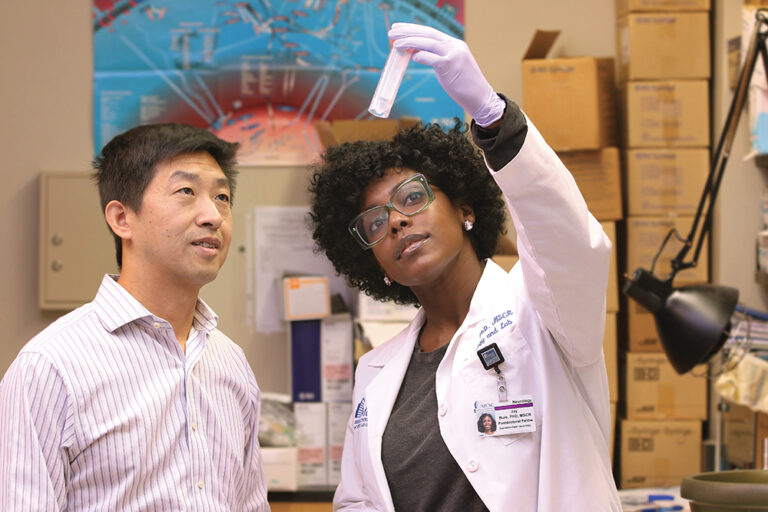Innovative Programs in Life Sciences Help Fuel South Carolina’s Economy
See how this cutting-edge industry is helping to drive innovation throughout the state.

While South Carolina doesn’t have a marketable nickname like “Silicon Valley” to capture the density and volume of its life sciences jobs, it is known across the U.S. for this burgeoning industry. The state leverages academic research assets and has generated more than 1,000 life sciences companies, adding approximately 4,800 jobs since 2017. And the key to its success — much like cells, organs and tissues in the human body — is the collaboration between its public and private entities. As a result, the life sciences sector here is diverse, from pharmaceutical manufacturers to chemical laboratories to device manufacturing.
670+
Life Science Firms are in South Carolina
Source: SCBIO
“We conducted a study that shows South Carolina has grown twice as fast as the average in the Southeast region in life sciences jobs,” says Dr. James Chappell, president and CEO of SCBIO, a statewide nonprofit that supports economic development through the life sciences industry. SCBIO advocates for its members and the state’s economy by ensuring a robust talent pipeline for employers in the life sciences industry.
Escalating with Education
Higher education institutions across the state, such as the Medical University of South Carolina (MUSC), Clemson University and the University of South Carolina, are significant drivers of life sciences innovation. For example, MUSC, a premier biomedical research institution, leads the state in receiving biomedical research funding. In the fiscal year 2021, the university brought in more than $328 million in biomedical research funds.
43,000+
the number of direct and indirect jobs in the life sciences sector in South Carolina
Source: SCBIO
Clemson University’s School of Health Research has more than 160 faculty members making local and national impacts. The university uses a “better together” research approach and has collaborated with Furman University, the Greenwood Genetic Center, MUSC, Prisma Health and the University of South Carolina School of Medicine Greenville. This has resulted in breakthroughs in health care delivery, access and affordability.
And at the University of South Carolina, researchers from the School of Public Health, School of Medicine Columbia and College of Social Work are investigating the everyday causes and prevention of chronic illnesses, such as diabetes and heart disease, as well as treatments.
Filling the Gap
The state’s four-year institutions aren’t the only ones creating talent pipelines. Chappell says SCBIO sought feedback from companies in the industry that identified a gap.
“We heard from industry leaders that they needed certain skill sets, and we went back to two-year colleges to create specialized upskill/reskill programs,” Chappell says. “We just saw our first graduates of the new SCBIO Life Sciences Pharmaceutical Manufacturing certificate program, which meets a growing need in our labor market.”
$78,000+
the average salary of a job in the life sciences sector in South Carolina
Source: SCBIO
Other new SCBIO programs include an angel credit that can help offset risk for investors, and the K-12 Workforce Initiative, which introduces pupils to jobs they could attain in the life sciences industry, including research, testing and medical labs, medical technology, biotechnology (drugs and pharmaceuticals), digital health, bio-science distribution and bio-agriculture. In addition, a new software program called Rad Lab has added a gamification element to discovering life sciences careers, targeting middle and high school students.
“It’s exciting to introduce students to jobs here in South Carolina so they can understand those opportunities are here,” Chappell says. “We still need to get that message out to our K-12 students and college students that these high-paying jobs with great career paths are here in South Carolina right now. They don’t need to look elsewhere.”
$11.4B
the economic impact of the life sciences sector in South Carolina
Source: SCBIO
Making Moves
Several employers in this industry are making significant advances. For example, Arthrex, a global medical device company, is investing more than $100 million to expand its operations in Anderson County. The expansion is expected to be completed by mid-2023 and create 500 new jobs. In addition, KIYATEC, a commercial-stage cancer diagnostics company born from technology developed at Clemson University, is expanding its operations in Greenville County, investing $5 million and creating 91 jobs.
400+
The number of patients and licensed technologies South Carolina inventors have earned in the past five years.
Source: SCBIO
“Now’s the time to get to South Carolina,” Chappell says. “It’s a great place to live, and we have room for growth. You could be a big fish in a fast-growing pond.”
If you’d like to learn more about South Carolina, check out the latest edition of South Carolina Business Climate.
